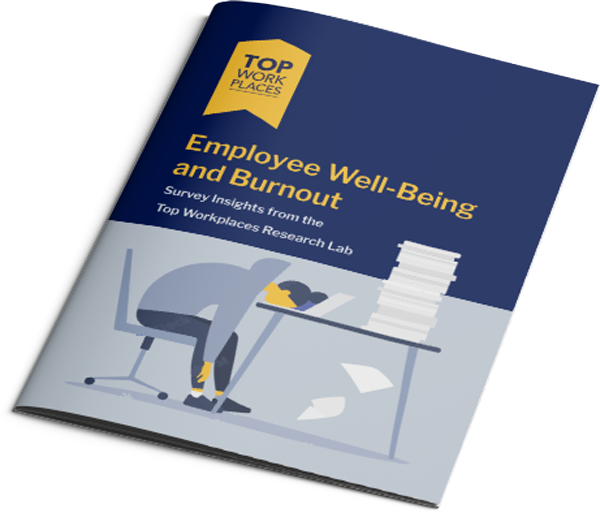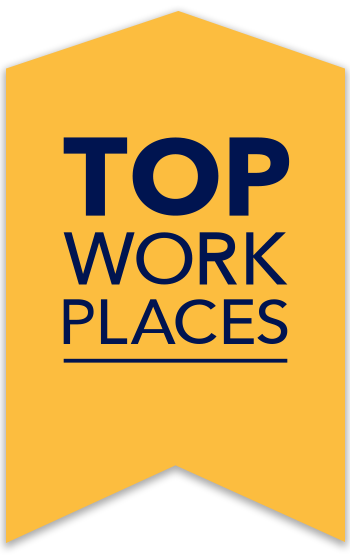
Dive into insights from the Top Workplaces Research Lab by downloading the infographic on Employee Well-Being and Burnout.
Preventing workplace burnout is as critical to business operations as investing in insurance or paying for electricity. Burnout prevention for lower-level employees, managers, and leaders ensures that everyone performs at their highest potential.
Burnout is one of the main reasons why employees leave a company — or worse, they quiet quit. Burnout prevention increases performance and preserves resources, which boosts profitability. Protecting the well-being of top talent means they are also more likely to be future company leaders, a win-win for everyone.
What is employee burnout?
Burnout occurs when there is emotional, mental, and physical exhaustion. It can come from work overload, pressure, role conflict and ambiguity, disconnected values, and unsupportive management. Prolonged exposure to these stressors leads to cynicism, exhaustion, and productivity loss.
Luckily, developments in burnout research show that increased education and manager support can address current problems and help prevent workplace burnout.
Causes of employee burnout
Body and mind exhaustion can come from many causes, including work overload, pressure, disconnected values, lack of manager support, and role ambiguity. Plus, negative connotations of burnout in the workplace can make people hide their problems instead of solving them.
One of these issues can lead anyone to burnout, including your top-performing employees. But a combination of these issues can build on each other, leading to faster and more severe burnout.
11 strategies to prevent employee burnout
Burnout prevention strategies are necessary for employee retention and productivity. Management teams must continuously explore strategies to find the best combination for their employees, which requires time, patience, and persistence. Here are some ideas to consider:
1. Recovery time
Productivity should not be confused with overworking. Exploring how to prevent burnout in the workplace starts with adding recovery time. It’s essential for managers to support their employees with a realistic workload and allow for breaks when needed.
Employees might need different amounts of recovery time, so checking in with employees ensures they get the recovery time they need. Paying attention to your highest performing, most productive employees and managers is also important, even if they seem okay. After all, everyone needs recovery time, no matter how much they think they can handle.
2. Encourage emotional boundary setting and communication
Communication is always key, especially when setting emotional boundaries. The topics that energize some employees might stress others, so it’s essential to set boundaries and talk about issues as soon as they happen.
Create a safe space for employees to discuss complex topics and set boundaries. Specific issues can be incredibly emotional for some employees. Avoiding those problems will prevent burnout and strengthen team relationships.
3. Foster social interaction
Community is a pillar of retention. It strengthens culture by connecting employees to their peers and work, naturally reducing burnout and other cultural issues. Social interaction between employees can minimize stress and improve workplace culture, but managers must ensure that every employee is included.
4. Set a clear purpose for employees
Creating a clear purpose is another way to reduce burnout in the workplace. Consider both company purpose and individual employee purpose. Managers can prevent burnout by reminding employees of their role expectations and why the organization values their work.
5. Mental health days
Good employers provide sick days, but great employers offer mental health days. Giving employees space to address their mental health outside of work prevents issues from surfacing in the workplace. Managers can support employees by encouraging the use of mental health days and reminding employees that this benefit is just as important as sick days.
6. Encourage employees to use their PTO
In addition to offering judgment-free mental health days, employees should be urged to their vacation time. Employees who feel too stressed to take time off are more susceptible to burn out, so encourage them to unplug and recharge.
7. Create equal workloads across the team
Ensuring equal workloads across teams is another effective strategy for preventing or managing burnout in the workplace. This can safeguard employees from feeling overwhelmed, which is a fast track to burnout.
Creating equal workloads across teams requires managers to evaluate their teams and distribute responsibilities evenly.
8. Include employees in decision-making processes
Employees who don’t feel heard are more likely to disengage. Employee feedback surveys are a great way to promote autonomy, communication, honesty, a sense of purpose, and transparency. Involving employees in decision making ensures they feel included and connected to the organization’s success.
9. Eliminate unnecessary rules
Flexible, hybrid work models are part of the new normal. Leaders and managers must reevaluate and amend processes that no longer work for their employees. Eliminating unnecessary tasks and introducing more efficient ones will improve job satisfaction, reconnect employees, and prevent burnout.
10. Train managers
Preventing burnout in the workplace starts and ends with managers. Consistent burnout prevention training will keep managers updated on the most effective ways to improve employee engagement and reduce the threat of burnout.
One of the qualities of a good manager is their ability to keep employees motivated. Providing managers with the tools and training necessary to do their job well will positively impact the whole organization. It will also help managers stay on top of best practices, new findings, and trends.
11. Be proactive
Ignoring employee burnout is one of the riskiest things a business can do. That’s why preparation is arguably the critical strategy for preventing burnout. Understanding the warning signs of burnout and the signs of engaged employees will help managers notice when employees start to struggle. Additionally, a burnout prevention plan is one of the most effective employee retention strategies.
Top Workplaces for Employee Well-Being
Top Workplaces are companies with well-being in mind. These leading organizations are intentional about driving a people-first culture. They’re recognized for their well-being initiatives and use the award as a recruitment strategy to attract new talent.
See the Top Workplaces for Employee Well-Being awards.
If your company is proud of its employee well-being initiatives, get recognized for it! Nominate your organization for Top Workplaces, the employer recognition program that offers awards in 60+ regional markets and national awards for culture and industry excellence.

